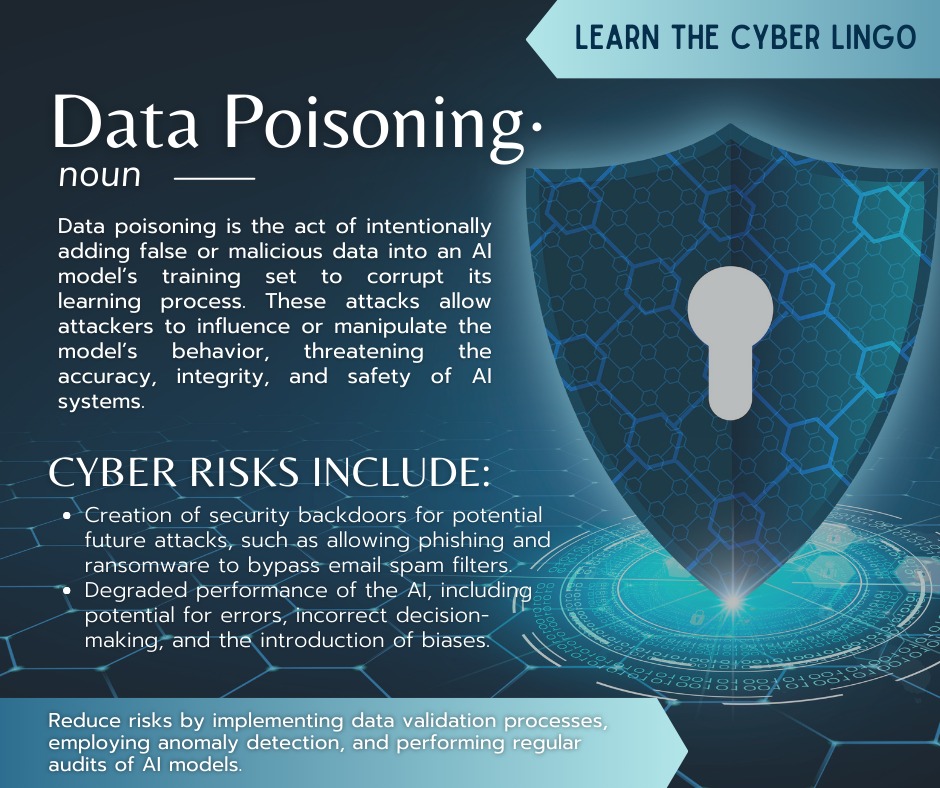-
Connect With Your Ottawa IT Service Company at (613) 828-1384
Connect With Your Ottawa IT Service Company at (613) 828-1384
Data poisoning, also known as AI poisoning, is a serious threat in artificial intelligence and machine learning. This type of cyberattack involves an adversary intentionally corrupting a training dataset to manipulate the behavior of the AI model, leading it to produce biased or harmful outputs. The rapid adoption of AI technologies in various sectors has made understanding the risks associated with data poisoning is crucial.
Imagine an AI model designed to detect fraud. If someone poisons the training data, the model might either fail to spot legitimate fraud or wrongly classify genuine transactions as fraudulent. This can have severe consequences for businesses and individuals alike. Protecting AI systems from these attacks needs robust strategies and continuous vigilance.
This blog post will teach you about data poisoning, its impacts and risks, and strategies to detect and mitigate these threats. Understanding these aspects is essential to safeguarding your AI projects and ensuring they perform as intended.
Data poisoning attacks aim to manipulate the training data of AI models, causing them to act in unintended ways. These attacks can target different aspects of the data and vary based on the adversary’s goals.
Data poisoning occurs when malicious actors intentionally alter training datasets used in AI and ML models. This manipulation can result in biased, skewed, or harmful outputs from the affected systems, and it may lead to the AI making erroneous decisions.
The primary objective is to compromise the model’s integrity by inserting incorrect, misleading, or harmful data during training. Such attacks can undermine the reliability of AI systems, making it critical to understand and defend against them.
There are several types of data poisoning attacks, each with different methods and goals.
One common type is the Backdoor Attack, where the attacker plants hidden triggers in the data. When these triggers are present in inputs, they cause the model to behave incorrectly.
Another type is the Label Flipping Attack, which involves changing the labels of data points. This confuses the model by making it learn incorrect associations.
A third type is the Targeted Attack, designed to cause specific, harmful outcomes. For example, an attacker might alter data to bypass a security measure in the AI system.
Effective defense strategies require understanding these data poisoning attacks to protect AI models from compromise.

Data poisoning poses significant threats to machine learning models and data integrity, leading to serious business and security risks. Understanding these impacts helps you mitigate potential damages.
Data poisoning can drastically alter the performance of your machine learning models. When adversaries manipulate training data, the model learns inaccurate patterns. These corrupted models then make incorrect predictions, affecting everything from fraud detection in finance to diagnostics in healthcare.
Examples include:
Addressing these issues requires continuous monitoring and robust validation processes.
Compromised data affects the integrity of datasets used for training and evaluating AI models. When attackers modify or inject false data, the reliability of your datasets is questioned, which in turn affects all dependent operations and decisions.
Key risks include:
Ensuring data integrity involves frequent audits, real-time monitoring, and employing advanced detection algorithms.
The implications of data poisoning extend beyond technical issues, posing real risks to businesses and security. Compromised models can lead to financial losses, damaged reputations, and even legal ramifications.
Impacts can manifest through:
Mitigating these risks involves strengthening cybersecurity measures, investing in robust AI frameworks, and maintaining vigilant security protocols. Being proactive is key to defending against data poisoning attacks.
Understanding both detection and mitigation is important for defending against data poisoning attacks. You will learn to identify these attacks, take preventive measures, and respond effectively.
Detecting data poisoning involves several methods:
Monitoring for changes in model performance can also help. A sudden drop in accuracy might indicate a poisoning event. Always validate sources of data and maintain strong access controls.
Preventing data poisoning requires a proactive approach:
You should also use diverse data sets and cross-validate with multiple sources. This reduces the risk of a single point of failure and helps maintain the integrity of your data.
Responding quickly to a data poisoning event is crucial:
To prevent loss, regularly back up your training data and models. Also, consider implementing rollback mechanisms to restore previous, untainted versions of your models. These steps will help minimize the damage and ensure your AI system remains robust.